- Region
- Águilas
- Alhama de Murcia
- Jumilla
- Lorca
- Los Alcázares
- Mazarrón
- San Javier
-
ALL AREAS & TOWNS
- AREAS
- SOUTH WEST
- MAR MENOR
- MURCIA CITY & CENTRAL
- NORTH & NORTH WEST
- TOWNS
- Abanilla
- Abarán
- Aguilas
- Alamillo
- Alcantarilla
- Aledo
- Alhama de Murcia
- Archena
- Balsicas
- Blanca
- Bolnuevo
- Bullas
- Cañadas del Romero
- Cabo de Palos
- Calasparra
- Camping Bolnuevo
- Campo De Ricote
- Camposol
- Canada De La Lena
- Caravaca de la Cruz
- Cartagena
- Cehegin
- Ceuti
- Cieza
- Condado de Alhama
- Corvera
- Costa Cálida
- Cuevas De Almanzora
- Cuevas de Reyllo
- El Carmoli
- El Mojon
- El Molino (Puerto Lumbreras)
- El Pareton / Cantareros
- El Raso
- El Valle Golf Resort
- Fortuna
- Fuente Alamo
- Hacienda del Alamo Golf Resort
- Hacienda Riquelme Golf Resort
- Isla Plana
- Islas Menores & Mar de Cristal
- Jumilla
- La Azohia
- La Charca
- La Manga Club
- La Manga del Mar Menor
- La Pinilla
- La Puebla
- La Torre
- La Torre Golf Resort
- La Unión
- Las Palas
- Las Ramblas
- Las Ramblas Golf
- Las Torres de Cotillas
- Leiva
- Librilla
- Lo Pagan
- Lo Santiago
- Lorca
- Lorquí
- Los Alcázares
- Los Balcones
- Los Belones
- Los Canovas
- Los Nietos
- Los Perez (Tallante)
- Los Urrutias
- Los Ventorrillos
- Mar De Cristal
- Mar Menor
- Mar Menor Golf Resort
- Mazarrón
- Mazarrón Country Club
- Molina de Segura
- Moratalla
- Mula
- Murcia City
- Murcia Property
- Pareton
- Peraleja Golf Resort
- Perin
- Pilar de la Horadada
- Pinar de Campoverde
- Pinoso
- Playa Honda
- Playa Honda / Playa Paraíso
- Pliego
- Portmán
- Pozo Estrecho
- Puerto de Mazarrón
- Puerto Lumbreras
- Puntas De Calnegre
- Region of Murcia
- Ricote
- Roda Golf Resort
- Roldan
- Roldan and Lo Ferro
- San Javier
- San Pedro del Pinatar
- Santiago de la Ribera
- Sierra Espuña
- Sucina
- Tallante
- Terrazas de la Torre Golf Resort
- Torre Pacheco
- Totana
- What's On Weekly Bulletin
- Yecla


- EDITIONS:
 Spanish News Today
Spanish News Today
 Alicante Today
Alicante Today
 Andalucia Today
Andalucia Today
Vía Crucis, la Unión, the birth of a new tradition, symbol of the renaissance of La Unión
The Vía Crucis, La Unión, Sábado de Pasión, 2011.
As an outsider, slowly peeling back the layers of this Region and trying to learn about, and understand, its past and what makes it the place it is today, we´ve had to spend a great deal of time researching the history of the region and the civilisations who formed it and shaped it.
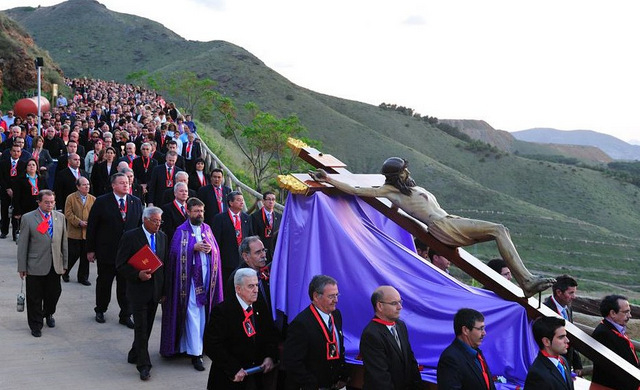
One of the most un-nerving discoveries has been the blight of the Spanish Civil War and the destruction of much of the religious heritage the region possessed, many of its most valuable and irreplacable sculptures 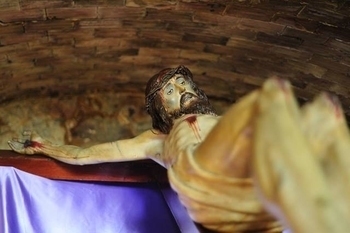 and artworks destroyed during 1935, and the years of strife and turmoil which followed.
and artworks destroyed during 1935, and the years of strife and turmoil which followed.
During the period of dictatorship so many historical traditions were put aside, and practices which had been a part of the annual rituals of life discontinued, and it was not until after the death of Franco, that some of these practises were resurrected.
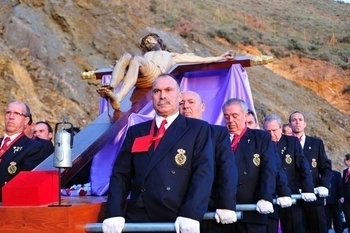 The march of modernity and changes in the social strata of traditional society has forced a re-evaluation of the church, and what it stands for, and although the widespread practise of divorce and acceptance of sexual orientation is changing the modern church, understanding of the value and importance
The march of modernity and changes in the social strata of traditional society has forced a re-evaluation of the church, and what it stands for, and although the widespread practise of divorce and acceptance of sexual orientation is changing the modern church, understanding of the value and importance 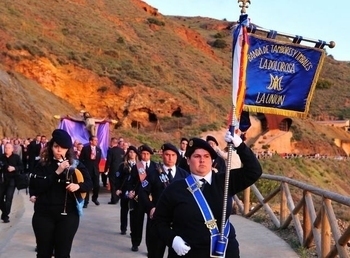 of the traditions it engenders are creating a new wave of participation in a more modern, and encompassing way.
of the traditions it engenders are creating a new wave of participation in a more modern, and encompassing way.
New brotherhoods are being created, and participation in the Cofradías, far from falling off is increasing, with new sculptures being commissioned and new "traditions" created to become part of the fibre which so binds Spain together, its faith.
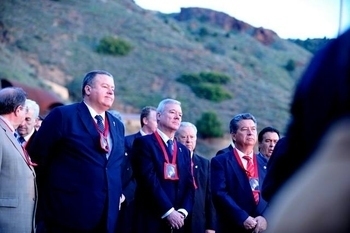 On Saturday night, we were part of a "new tradition" in La Unión, the creation of a Vía Crucis from the Mina Agrupa Vicenta, down into the town of La Unión, an uplifting and moving experience which it was a pleasure to be involved in, religion or no religion.
On Saturday night, we were part of a "new tradition" in La Unión, the creation of a Vía Crucis from the Mina Agrupa Vicenta, down into the town of La Unión, an uplifting and moving experience which it was a pleasure to be involved in, religion or no religion.
What struck us most, as part of the slow human chain of candles and mining lamps which wound its way down from the mine, was the symbolism of this Vía Crucis, the birth of a new tradition symbolising the rebirth 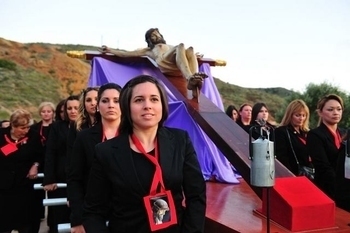 of La Unión itself, as it works hard to emerge from the years of unemployment following the closure of its mining industry to its current mission to re-establish itself on the tourism map through the creation of attractions relating to its mining history, the catalyst for all that being the opening of the mining museum from which this Vía Crucis departed.
of La Unión itself, as it works hard to emerge from the years of unemployment following the closure of its mining industry to its current mission to re-establish itself on the tourism map through the creation of attractions relating to its mining history, the catalyst for all that being the opening of the mining museum from which this Vía Crucis departed.
From early evening, the tourist train and minibus ferried participants from the carpark below, up to the 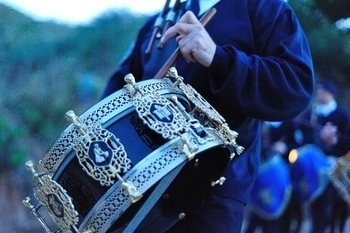 entrance of the mine along the first section of route 33, which links the town of La Unión with Portman Bay, although many more took the opportunity to enjoy the route on foot, warm breezes and the haziness of a setting sun creating atmosphere and expectation.
entrance of the mine along the first section of route 33, which links the town of La Unión with Portman Bay, although many more took the opportunity to enjoy the route on foot, warm breezes and the haziness of a setting sun creating atmosphere and expectation.
We walked, keen to finish the photography we had begun on our visit to the mines, when a torrential cloudburst had made a visit to the washing points and exploration of the mining equipment outside an 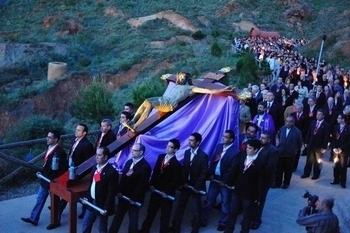 impossibility.
impossibility.
Slowly, slowly, money and effort is being invested into adding more equipment to the Mining park area and ecologists, ANSE, are working with the council to replant the area with thousands of native plants, the aim being to build a forest along the old mining route.
At the top, the figure of Cristo de los Mineros, Christ of the miners waited, alongside a small chapel in memory of the thousands who died in the warrens of mines which riddle the whole of the Sierra Minera, 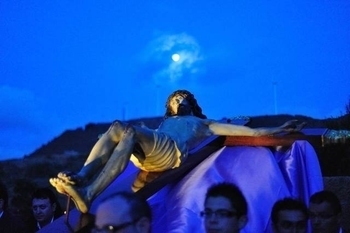 scented with candles and flowers, many of those congregated at the top having worked in the mines or lost family members to the debilitating lung diseases which killed tens of thousands who spent their lives here.
scented with candles and flowers, many of those congregated at the top having worked in the mines or lost family members to the debilitating lung diseases which killed tens of thousands who spent their lives here.
The words of an old miner at the inauguration of the mine nearly a year ago seemed so apt on this occasion, 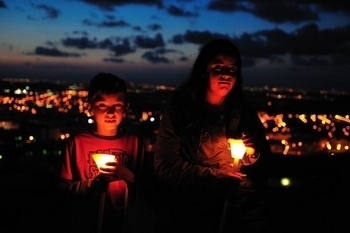 with mining lamps lit and hung alongside the stations of the cross,
with mining lamps lit and hung alongside the stations of the cross,
"people didn´t retire in La Unión, they died."
This inaugural event was attended by the president of the Region of Murcia, Ramón Luis Valcárcel, along with the Mayor of La Unión, Francisco Bernabé.
At 8pm, as the sun was sinking behind the ravaged hills of the Sierra Minera, the procession set off, accompanied by drummers and a lone piper, slowly piping the figure of Christ down along the Vía Crucis, 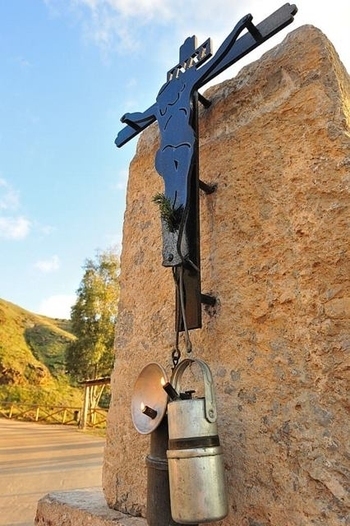 stopping at each of the 14 stations for a reading, relating the Passion of Christ.
stopping at each of the 14 stations for a reading, relating the Passion of Christ.
As it grew dark, the torchlit procession could be seen from below snaking around the curves of Route 33, the sound of the pipes echoing around the basin formed by millions of tons of sterile waste, the by product of mineral extraction and washing, until finally, it crossed the railway track and finished at the Church in the town itself.
It was a real privilege to have been part of this renaissance, an atmospheric and moving event, something unique in the region and which will undoubtedly become an important element of the Semana Santa in the Region of Murcia.
 And interesting to experience yet another completely different Vía Crucis, each one totally contrasting to the others, offering a unique insight into the traditions of the region.
And interesting to experience yet another completely different Vía Crucis, each one totally contrasting to the others, offering a unique insight into the traditions of the region.
There´s only one way to discover what happens here, and that´s to go for yourself.
If you´re interested to know more about La Unións history,read the "potted history" written to help explain its past and enable visitors to truly understand what they´re seeing when they visit this town. Click History of La Únión.
Cartagena
El Carmoli
Islas Menores and Mar de Cristal
La Manga Club
La Manga del Mar Menor
La Puebla
La Torre Golf Resort
La Union
Los Alcazares
Los Belones
Los Nietos
Los Urrutias
Mar Menor Golf Resort
Pilar de la Horadada
Playa Honda / Playa Paraiso
Portman
Roldan and Lo Ferro
San Javier
San Pedro del Pinatar
Santa Rosalia Lake and Life resort
Terrazas de la Torre Golf Resort
Torre Pacheco
Aledo
Alhama de Murcia
Bolnuevo
Camposol
Condado de Alhama
Fuente Alamo
Hacienda del Alamo Golf Resort
Lorca
Mazarron
Puerto de Mazarron
Puerto Lumbreras
Sierra Espuna
Totana
Abaran
Alcantarilla
Archena
Blanca
Corvera
El Valle Golf Resort
Hacienda Riquelme Golf Resort
Lorqui
Molina de Segura
Mosa Trajectum
Murcia City
Peraleja Golf Resort
Ricote
Sucina
Condado de Alhama
El Valle Golf Resort
Hacienda del Alamo Golf Resort
Hacienda Riquelme Golf Resort
Islas Menores and Mar de Cristal
La Manga Club
La Torre Golf Resort
Mar Menor Golf Resort
Mazarron Country Club
Mosa Trajectum
Peraleja Golf Resort
Santa Rosalia Lake and Life resort
Terrazas de la Torre Golf Resort
La Zenia
Lomas de Cabo Roig
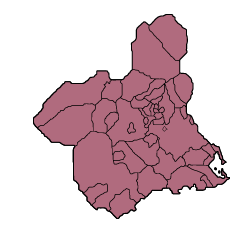
CAMPOSOL TODAY Whats OnCartagena SpainCoronavirusCorvera Airport MurciaMurcia Gota Fria 2019Murcia property news generic threadWeekly Bulletin
